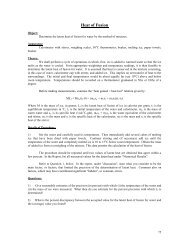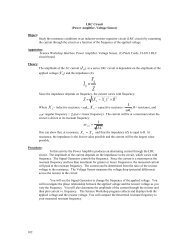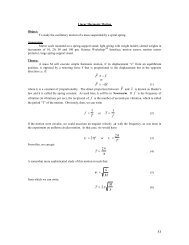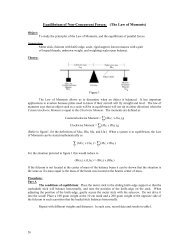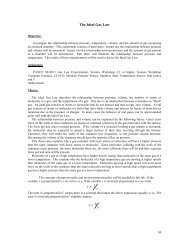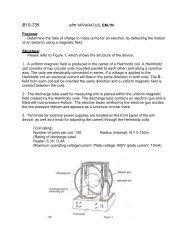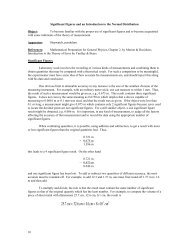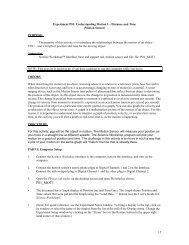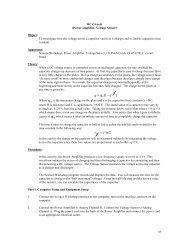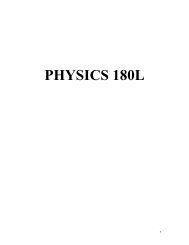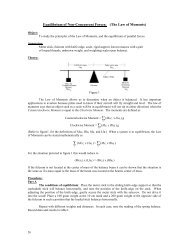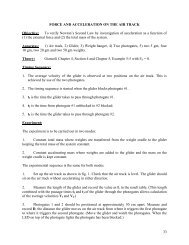Old Measuring the Coefficient of Linear Expansion for ... - Physics
Old Measuring the Coefficient of Linear Expansion for ... - Physics
Old Measuring the Coefficient of Linear Expansion for ... - Physics
Create successful ePaper yourself
Turn your PDF publications into a flip-book with our unique Google optimized e-Paper software.
<strong>Measuring</strong> <strong>the</strong> <strong>Coefficient</strong> <strong>of</strong> <strong>Linear</strong> <strong>Expansion</strong><br />
<strong>for</strong> Copper, Steel, and Aluminum<br />
Introduction:<br />
Most materials expand somewhat when heated through a temperature range that does not produce<br />
a change in phase. The added heat increases <strong>the</strong> average amplitude <strong>of</strong> vibration <strong>of</strong> <strong>the</strong> atoms in <strong>the</strong> material<br />
which increases <strong>the</strong> average separation between <strong>the</strong> atoms.<br />
! T . If T<br />
! , is generally proportional to L and T<br />
Suppose an object <strong>of</strong> length L undergoes a temperature change <strong>of</strong> magnitude<br />
reasonably small, <strong>the</strong> change in length, L<br />
ma<strong>the</strong>matically:<br />
! L = " L!<br />
T<br />
where ! is called <strong>the</strong> coefficient <strong>of</strong> linear expansion <strong>for</strong> <strong>the</strong> material.<br />
! is<br />
! . Stated<br />
For materials that are not isotropic, such as an asymmetric crystal <strong>for</strong> example, ! can have a<br />
different value depending on <strong>the</strong> axis along which <strong>the</strong> expansion is measured. ! can also vary somewhat<br />
with temperature so that <strong>the</strong> degree <strong>of</strong> expansion depends not only on <strong>the</strong> magnitude <strong>of</strong> <strong>the</strong> temperature<br />
change, but on <strong>the</strong> absolute temperature as well.<br />
In this experiment, you will measure ! <strong>for</strong> copper, aluminum, and steel. These metals are isotropic so that<br />
! need only be measured along one dimension. Also, within <strong>the</strong> limits <strong>of</strong> this experiment, ! does not<br />
vary with temperature.<br />
Apparatus:<br />
Three tubes <strong>of</strong> different metals, expansion base attached to a dial gauge, Ohmmeter, steam<br />
generator, two plastic water tubes, and a wooden block.<br />
Procedure:<br />
1) Measure L, <strong>the</strong> length <strong>of</strong> <strong>the</strong> copper tube at room temperature. Measure from <strong>the</strong> inner edge <strong>of</strong> <strong>the</strong><br />
stainless steel pin on one end, to <strong>the</strong> inner edge <strong>of</strong> <strong>the</strong> angle bracket at <strong>the</strong> o<strong>the</strong>r end (see Figure 1).<br />
Record your results in Table 1.<br />
2) Mount <strong>the</strong> copper tube in <strong>the</strong> expansion base as shown in Figure 2. The stainless steel pin on <strong>the</strong><br />
tube fits into <strong>the</strong> slot on <strong>the</strong> slotted mounting block and <strong>the</strong> bracket on <strong>the</strong> tube presses against<br />
<strong>the</strong> spring arm <strong>of</strong> <strong>the</strong> dial gauge.<br />
Note: Slide or push <strong>the</strong> tube to one side <strong>of</strong> <strong>the</strong> slide<br />
support. Drive <strong>the</strong> thumbscrew against <strong>the</strong> pin until<br />
<strong>the</strong> tube can no longer be moved. Use this as your<br />
reference point.<br />
77
3) Use one <strong>of</strong> <strong>the</strong> provided<br />
thumbscrews to attach <strong>the</strong><br />
<strong>the</strong>rmistor lug to <strong>the</strong><br />
threaded hole in <strong>the</strong><br />
middle <strong>of</strong> <strong>the</strong> copper tube.<br />
The lug should be aligned<br />
with <strong>the</strong> axis <strong>of</strong> <strong>the</strong> tube,<br />
as shown in Figure 2, so<br />
<strong>the</strong>re is maximum contact<br />
between <strong>the</strong> lug and <strong>the</strong><br />
tube.<br />
4) Place <strong>the</strong> foam insulator over <strong>the</strong> <strong>the</strong>rmistor lug.<br />
5) Plug <strong>the</strong> leads <strong>of</strong> your ohmmeter into <strong>the</strong> banana plug connectors labeled THERMISTOR in <strong>the</strong> center <strong>of</strong><br />
<strong>the</strong> expansion base.<br />
6) Measure and record R rm <strong>the</strong> resistance <strong>of</strong> <strong>the</strong> <strong>the</strong>rmistor at room temperature. Record this value in <strong>the</strong> table.<br />
7) Use tubing to attach your steam generator to <strong>the</strong> end <strong>of</strong> <strong>the</strong> copper tube. Attach it to <strong>the</strong> end far<strong>the</strong>st from<br />
<strong>the</strong> dial gauge.<br />
8) Use a book or a block <strong>of</strong> wood to raise <strong>the</strong> end <strong>of</strong> <strong>the</strong> expansion base at which steam enters <strong>the</strong> tube a few<br />
centimeters is sufficient. This will allow any water that condenses in <strong>the</strong> tube to drain out. Place a container<br />
under <strong>the</strong> o<strong>the</strong>r end <strong>of</strong> <strong>the</strong> tube to catch <strong>the</strong> draining water.<br />
9) Turn <strong>the</strong> outer casing <strong>of</strong> <strong>the</strong> dial gauge to align <strong>the</strong> zero point on <strong>the</strong> scale with <strong>the</strong> long indicator needle.<br />
As <strong>the</strong> tube expands, <strong>the</strong> indicator needle will move in a counterclockwise direction.<br />
10) Turn on <strong>the</strong> steam generator. As steam begins to flow, watch <strong>the</strong> dial gauge and <strong>the</strong> ohmmeter. When <strong>the</strong><br />
<strong>the</strong>rmistor resistance stabilizes, record <strong>the</strong> resistance (R hot ) in Table 1. Also record <strong>the</strong> expansion <strong>of</strong> <strong>the</strong><br />
tube length ( ! L ) as indicated by <strong>the</strong> displacement <strong>of</strong> <strong>the</strong> indicator on <strong>the</strong> dial gauge. (Each increment on<br />
<strong>the</strong> dial gauge is equivalent to 0.01 mm <strong>of</strong> tube expansion.) Note that ! L is <strong>the</strong> difference between <strong>the</strong><br />
dial gauge readings.<br />
11) Repeat <strong>the</strong> experiment <strong>for</strong> <strong>the</strong> steel and aluminum tubes.<br />
78
Data and Calculations:<br />
TABLE 1 Data and Calculations<br />
DATA<br />
L (mm) R rm (! ) ! L (mm) R hot( )<br />
CALCULATIONS<br />
! T rm(<br />
o<br />
C)<br />
T hot( C)<br />
o<br />
T<br />
!<br />
o<br />
( C)<br />
Copper<br />
Steel<br />
Aluminum<br />
1) Use <strong>the</strong> Thermistor Conversion Table on <strong>the</strong> next page, or <strong>the</strong> one on <strong>the</strong> top <strong>of</strong> <strong>the</strong> expansion base, to<br />
convert your <strong>the</strong>rmistor resistance measurements, R rm and R hot ,into temperature measurements, T rm and<br />
T hot. . Record your results in <strong>the</strong> table.<br />
2) Calculate ! T = T hot - T rm . Record <strong>the</strong> result in <strong>the</strong> table.<br />
Using <strong>the</strong> equation<br />
! L = " L!<br />
T , calculate ! <strong>for</strong> copper, steel, and aluminum.<br />
!<br />
Cu<br />
!<br />
steel<br />
!<br />
Al<br />
=<br />
=<br />
=<br />
Questions:<br />
Compare <strong>the</strong>se values with your experimental values. What is <strong>the</strong> percentage error in each case? Is your<br />
experimental error consistently high or low?<br />
" = 17x10<br />
! 6<br />
/<br />
o<br />
C " = 11x10<br />
! 6<br />
/<br />
o<br />
C<br />
" = 23x10<br />
! 6<br />
/<br />
o<br />
C<br />
C u<br />
steel<br />
Al<br />
On <strong>the</strong> basis <strong>of</strong> your answers in question 1, speculate on <strong>the</strong> possible sources <strong>of</strong> error in your experiment. How<br />
might you improve <strong>the</strong> accuracy <strong>of</strong> <strong>the</strong> experiment?<br />
From your result, can you calculate <strong>the</strong> coefficients <strong>of</strong> volume expansion <strong>for</strong> copper, aluminum, and steel?.<br />
(i.e. ! V = " V!<br />
T ).<br />
vol<br />
79
80<br />
THERMISTOR CONVERSION TABLE:<br />
Temperature versus Resistance



